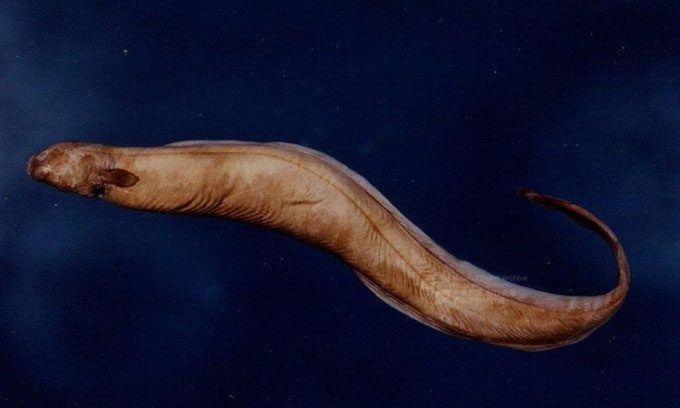The bluntnose eel can enter the hearts of sharks and survive by digesting the host’s blood, according to a report by Nature on June 26.

The bluntnose eel typically lives at depths of 500 – 1,800m. (Photo: Weird Animals)
Inside the hearts and organs of sharks, scientists occasionally encounter a rare parasite species known as the bluntnose eel (Simenchelys parasitica). In a case from 1997, two eels were found inhabiting the heart of a large shortfin mako shark (Isurus oxyrinchus) and were digesting the shark’s blood. A decade later, in 2007, bluntnose eels were discovered in the heart, body cavity, and muscles of a small-toothed sand shark (Odontaspis ferox), according to Science Alert. In fact, bluntnose eels do not need to be parasites; they can comfortably live underwater, feeding on animal carcasses on the seabed. However, bluntnose eels prefer to burrow into the flesh of larger fish.
Researchers were unaware of eels parasitizing sharks until they collected the body of a male shortfin mako shark from the bottom of the North Atlantic Ocean in June 1992 and brought it ashore in Montauk, New York. The large shark, weighing 395 kg, had become entangled in a fishing line and died when brought aboard. Its pale color indicated it had been lying on the muddy seabed for some time. The mako shark’s body was placed in a cold storage facility for researchers to carefully examine in order to determine the cause of death.
The next day, when biologists Janine Caira from the University of Connecticut and Nancy Kohler from the Northeast Fisheries Science Center dissected the shark, they discovered two nearly mature female bluntnose eels, measuring 21 and 24 cm, residing in its heart. Both had died due to being brought ashore and stored cold but appeared to have been quite healthy beforehand. Additionally, there was evidence that the eels had been hiding in the shark’s heart for some time. According to the research team led by Caira, the stomachs of both eels were filled with blood, indicating they had been inside the shark long enough to feed. The shark’s heart also showed damage that was absent in six other non-parasitized shortfin mako sharks.
However, scientists could not find evidence of how the eels entered the shark’s heart from the outside. They speculated that the eels encountered a shark that was injured or dead from entanglement and took the opportunity to feed. Before or after the animal died, the two eels likely entered through the gills or throat. They then moved into the circulatory system via the branchial artery or aorta and made their way to the heart, digesting blood to survive throughout the process.
In 2007, researchers found the body of a female tiger shark measuring 3.7 meters floating at sea near Fuerteventura in the Canary Islands. Inside it were several bluntnose eels located in the heart and muscle tissues along the spine. This shark was mature but had completely lost its ovaries, possibly consumed by the eels or due to natural degeneration, according to the research team led by biologist Ian Fergusson. It is possible that the eels contributed to the shark’s death, as no external or internal injuries were found. Both cases reflect the bluntnose eel’s opportunistic parasitism survival strategy.


















































